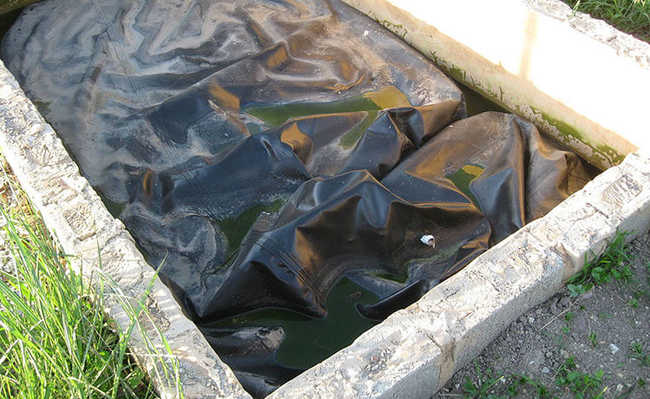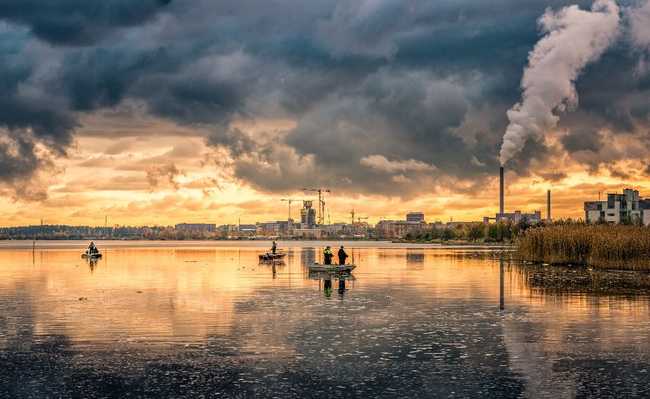What are greenhouse gases
Learn about the main greenhouse gases and their influence on global warming

Greenhouse gases (GHG) are gases that absorb a part of the sun's rays and redistribute them in the form of radiation in the atmosphere, heating the planet in a phenomenon called the greenhouse effect. The main GHG we have are: CO2, CH4, N2O, O3, halocarbons and water vapor.
The designation greenhouse effect was given in analogy to the heating generated by greenhouses, usually made of glass, in the cultivation of plants. Glass allows the free passage of sunlight and this energy is partly absorbed, partly reflected. The absorbed part has difficulty passing through the glass again, being radiated back to the interior environment.
The same reasoning can be used for the warming of the Earth, where greenhouse gases play the role of glass. The sun, being the Earth's main source of energy, emits a set of radiations called the solar spectrum. This spectrum is composed of light radiation (light) and heat radiation (heat), in which infrared radiation stands out. Luminous radiation has a short wavelength, easily crossing the atmosphere, while infrared radiation (heat radiation) has a long wavelength, having difficulty crossing the atmosphere and being absorbed by greenhouse gases when they perform this feat.
Watch this video produced by Earth Minute about how greenhouse gases really work:
Also check the eCycle Portal video about the issue:
Why is the intensification of the greenhouse effect worrying?
The greenhouse effect, as explained, is a natural phenomenon that allows the existence of life on Earth as we know it, since without it the heat would escape, causing a cooling that would make the planet uninhabitable for many species.
The problem is that this effect has been greatly intensified due to human actions - there was a record of CO2 emission into the atmosphere in 2014, according to the World Meteorological Organization (WMO). This intensification is mainly due to the burning of fossil fuels, by industries and automobiles, the burning of forests and livestock, resulting in global warming.
According to the WMO, in the last 140 years the global average temperature has increased by 0.7°C. While it doesn't sound like much, it was enough to cause significant climate change. And the forecast is that, if the pollution rate continues to increase at the current rate, in 2100 the average temperature will increase by 4.5°C to 6°C.
This increase in global temperature brings as a consequence the melting of large masses of ice in the polar regions, causing a rise in sea level, which can lead to problems such as the submersion of coastal cities and forced migration of people; increase in natural disasters such as hurricanes, typhoons and cyclones; desertification of natural areas; more frequent droughts; changes in rainfall patterns; problems in food production, as changes in temperature can affect production areas; and interference with biodiversity, which can drive many species to extinction. We can see then that global warming is more than a rise in temperature - it is related to the most varied climate changes.
What are the main gases causing this effect?
1. CO2
Carbon dioxide is a liquefied gas, colorless, odorless, non-flammable, soluble in water, slightly acidic and identified by the Intergovernmental Panel on Climate Change (IPCC) as the main contributor to global warming, being in 78% of human emissions and representing 55% of total global greenhouse gas emissions.
This gas is produced naturally in respiration, the decomposition of plants and animals, and natural forest fires. Its production is natural and essential to life, the problem lies in the large increase in this CO2 production, which harms the planet.
Man is largely responsible for this increase in the concentration of carbon dioxide in the atmosphere. The burning of fossil fuels and deforestation are the two main activities contributing to the high release of this gas into the atmosphere.
The burning of fossil fuels, substances of mineral origin formed by carbon compounds, including mineral coal, natural gas and petroleum derivatives, such as gasoline and diesel oil, used to generate electricity and run automobiles, are the responsible for the exaggerated emission of carbon dioxide into the atmosphere, causing pollution and changes in the thermal balance of the planet. Deforestation is also responsible for causing an imbalance of carbon dioxide in the atmosphere, as in addition to releasing gas by burning wood, it reduces the number of trees responsible for photosynthesis, which absorb the CO2 present in the atmosphere.
The intensification of the greenhouse effect not only affects terrestrial life, it also has a great impact on marine life. Seawater heating acts directly on corals. Corals are cnidarians that live in symbiosis with an alga of the genus symbiodinium (zooxanthellas). These algae lodge in the cavities of the calcium carbonate exoskeleton (white color) of corals, which help them remove sunlight that penetrates the seawater, and the excess energy produced through photosynthesis of these algae is transferred to the coral ( besides coloring it). When the temperature of seawater increases, these algae begin to produce chemicals that are toxic to the coral. To defend himself, the cnidarian has the strategy of expelling the algae. The expulsion process is traumatic and that excess energy that the algae gave the coral disappears overnight. The result is the bleaching and death of these corals (see more in our article “Climate change will lead to coral bleaching, UN alert”).
Studies prove that livestock and its by-products are responsible for at least 32 billion tonnes of carbon dioxide (CO2) per year, or 51% of all greenhouse gas emissions worldwide - see more in "Far beyond animal exploitation: cattle breeding promotes consumption of natural resources and environmental damage on a stratospheric scale"
In addition, the high concentration of CO2 causes its partial pressure to increase in relation to the gas mixture in the atmosphere, which accelerates its absorption when in direct contact with a liquid, as in the case of the oceans. This greater absorption causes an imbalance, as CO2 in contact with water forms carbonic acid (H2CO3), which breaks down and releases H+ ions (responsible for the increase in acidity in the medium), carbonate and bicarbonate ions, saturating the Ocean. Ocean acidification is responsible for hampering the ability of calcifying organisms to form shells, leading to their disappearance (see more in our article "Ocean acidification: a serious problem for life on the planet").
Furthermore, CO2 has a long residence time in the atmosphere, ranging from 50 to 200 years; so even if we managed to stop issuing it, it would take a long time for the planet to recover. This shows the need to reduce emissions as much as possible, allowing carbon dioxide to be absorbed naturally by the oceans and vegetation, especially forests, and using techniques to neutralize the CO2 already emitted.
Like carbon dioxide, other greenhouse gases impact the planet. To build a comparative pattern between the global warming potentials of these gases, the concept of carbon equivalent (CO2-equivalent) was created. This concept is based on the representation of other greenhouse gases in CO2, so the greenhouse effect of each gas in CO2 is calculated by multiplying the amount of a gas by its Global Warming Potential (Global Warming Potential - GWP), which is related to the capacity of each of them to absorb heat in the atmosphere (radiative efficiency) in a given time (usually 100 years), compared to the same heat absorption capacity of CO2.
2. CH4
Methane is a colorless, odorless gas with little solubility in water and which becomes a highly explosive mixture when added to air. It is the second most important greenhouse gas, contributing about 18% of global warming. Its concentration is now around 1.72 parts per million by volume (ppmv), increasing at a rate of 0.9% per year.
Its production by natural processes comes mainly from swamps, termite activities and oceans. The increase in its concentration in the atmosphere, however, is mainly due to biological processes, such as anaerobic decomposition (without oxygen) of organisms, animal digestion and biomass burning, in addition to being present in landfills, in the treatment of liquid effluents and in landfills , in cattle raising, in rice fields, in the production and distribution of fossil fuels (gas, oil and coal) and in hydroelectric reservoirs.
Among the productions resulting from human factors, it was evaluated by the Intergovernmental Panel on Climate Change (IPCC) that half of all methane emissions originate from agriculture, from the stomach of cattle and sheep, from excrement deposits used as fertilizers and also from plantations of rice. As population growth only tends to increase, so does the release of methane.
Methane has a shorter residence time (ten years) in the atmosphere when compared to carbon dioxide, however its warming potential is much greater, having 21 times more impact than CO2 (see more in our article “Methane gas shoots up and threatens meta of 2 degrees”). In addition to its high capacity to absorb infrared radiation (heat), methane generates other greenhouse gases, such as CO2, tropospheric O3 and stratospheric water vapor. If there were equal amounts of methane and carbon dioxide in the atmosphere, the planet would be uninhabitable.
A large sink of this greenhouse gas occurs through the chemical reaction between it and the hydroxyl radical (OH) in the troposphere, being responsible for removing more than 90% of the emitted methane. This process is natural, but affected by the reaction of hydroxyl with other human-generated gas emissions, mainly carbon monoxide (CO) and hydrocarbons emitted by vehicle engines. In addition to this, there are two smaller sinks, which are absorption by aerated soils and transport to the stratosphere. In order for methane to stabilize its concentrations present in the atmosphere, an immediate reduction of 15 to 20% of global emissions would be necessary.
3. N2O
Nitrous oxide is a colorless gas, with a pleasant odor, low melting and boiling points, non-flammable, non-toxic and with low solubility. It is one of the main gases contributing to the intensification of the greenhouse effect and consequent global warming. Although there is a low emission in relation to other gases, its greenhouse effect is about 300 times more intense than that of CO2 and it remains in the atmosphere for a long time - about 150 years. N2O can absorb a very high amount of energy, being the gas that causes the most destruction in the ozone layer, responsible for protecting the earth's surface against ultraviolet radiation.
N2O can be produced naturally by forests and oceans. Its emission process takes place during the denitrification of the nitrogen cycle. Nitrogen (N2) present in the atmosphere is captured by plants and converted to ammonia (NH3) or ammonium ions (NH4+) in a process called nitrification. These substances are deposited in the soil and later used by plants. The deposited ammonia can go through a nitrification process, generating nitrates. And, through the denitrification process, microorganisms present in the soil can transform nitrates into gaseous nitrogen (N2) and nitrous oxide (N2O), emitting them to the atmosphere.
The main human source of nitrous oxide emission is agricultural activity (approximately 75%), while energy and industrial production and biomass burning contribute approximately 25% of emissions. The IPCC points out that about 1% of the nitrogen fertilizer used in plantations ends up in the atmosphere in the form of nitrous oxide.
In agricultural activity there are three sources of N2O production: agricultural soils, animal production systems and indirect emissions. The addition of nitrogen to the soil can occur through the use of synthetic fertilizers, animal manure or crop residues. And its release can occur via nitrification and denitrification processes carried out by bacteria in the soil, or by the decomposition of manure. Indirect emissions can occur, for example, due to the increase in N2O production in aquatic systems, as a result of a leaching process (erosion with washing of nutrients) of agricultural soils.
In energy production, combustion processes can form N2O by burning fuel and oxidizing atmospheric N2. Large amounts of this GHG are emitted by vehicles equipped with catalytic converters. Biomass burning, on the other hand, releases N2O during vegetation burns, garbage burning and deforestation.
There is still a small but significant emission of this gas into the atmosphere that comes from industrial processes. These processes include the production of adipic acid and nitric acid.
A natural sink for this gas is photolytic reactions (in the presence of light) in the atmosphere. In the stratosphere, the concentration of nitrous oxide decreases with height, establishing a vertical gradient in its mixing rate. A fraction of N2O emitted on the surface undergoes decomposition, mainly by ultraviolet photolysis, when entering the stratosphere via tropopause.
According to the IPCC, to stabilize the current concentrations of nitrous oxide there should be an immediate reduction of around 70 to 80% of its production.
4. O3
Stratospheric ozone is a secondary pollutant, that is, it is not directly emitted by human activities, but is formed through a reaction with other pollutants released into the atmosphere.
In the stratosphere, this compound is found naturally and has the important function of absorbing solar radiation and preventing the entry of most ultraviolet rays. However, when formed in the troposphere from the addition of other pollutants, it is highly oxidizing and harmful.
Tropospheric ozone can be obtained in limited quantities due to displacement of stratospheric ozone and in greater quantity by complex photochemical reactions associated with the emission of gases by man, usually nitrogen dioxide (NO2) and volatile organic compounds. These pollutants are mainly released in the burning of fossil fuels, fuel volatilization, animal husbandry and agriculture.
In the atmosphere, this compound actively contributes to intensifying the greenhouse effect, with a greater potential than CO2, and is responsible for gray smoke in cities. Its high concentration can cause problems for human health, the main effects being the worsening of symptoms of asthma and respiratory deficiency, as well as other pulmonary diseases (emphysema, bronchitis, etc.) and cardiovascular (arteriosclerosis). In addition, long-term exposure can lead to reduced lung capacity, development of asthma, and reduced life expectancy.
5. Halocarbons
The best known halocarbons in this group of gases are chlorofluorocarbons (CFCs), hydrochlorofluorocarbons (HCFCs) and hydrofluorocarbons (HFCs).
Chlorofluorocarbon is an artificial carbon-based substance that contains chlorine and fluorine.Its use began around the 1930s, as an alternative to ammonia (NH3), as it is less toxic and non-flammable, in refrigeration and air conditioning, foams, aerosols, solvents, cleaning products and fire extinguishers industries.
These compounds were considered inert until the 1970s, when they were discovered to cause holes in the ozone layer. The depletion of the ozone layer favors the entry of ultraviolet rays that cause the greenhouse effect and, at the same time, increase the risks to human health, as in the case of skin cancer caused by excessive sun exposure.
With these data, Brazil, among other countries, adhered to the Vienna Convention and the Montreal Protocol in 1990, committing, through Decree 99.280/06/06/1990, to completely eliminate CFCs by January 2010, among other measures . The targets were not met, but there is a great current trend of reversing damage to the ozone layer, as reported by the United Nations Development Program (UNDP). The expectation is that, around 2050, the layer will be restored to pre-1980 levels.
The destruction of the ozone layer by these compounds is great. Degradation of the layer occurs in the stratosphere, where sunlight photolizes these compounds, releasing chlorine atoms that react with ozone, decreasing their concentration in the atmosphere and destroying the ozone layer.
First, ozone degradation occurs by the decomposition of CFC molecules through solar radiation in the stratosphere:
CH3Cl (g) → CH3 (g) + Cl(g)
Then, the chlorine atoms that were released react with ozone, according to the following equation:
Cl(g) + O3 → ClO(g) + O2 (g)
The ClO(g) formed will react again with the free oxygen atoms, forming more chlorine atoms, which will react with the oxygen, and so on.
ClO(g) + O (g) → Cl(g) + O2 (g)
As the reaction of chlorine atoms with ozone occurs 1.5 thousand times faster than the reaction between free oxygen atoms present in the atmosphere that decompose the ozone, there is an intense destruction of the ozone layer. Thus, one chlorine atom is capable of destroying 100 ozone molecules.
To replace the use of CFCs, HCFCs were produced, which are much less harmful to the ozone layer, but still cause damage and are major contributors to the intensification of the greenhouse effect.
HFC gases interact with greenhouse gases, contributing to global warming. These gases have a much greater radioactive efficiency than carbon dioxide, as compared to the Global Warming Potential (GWP). The development of these compounds reduced the problem of depletion of the ozone layer, but increased the planet's temperature, due to global warming generated by the emission of these compounds.
See also the video produced by the National Institute for Space Research (Inpe) on the degradation of the ozone layer by CFCs.
6. Water vapor
Water vapor is the biggest contributor to the natural greenhouse effect, as it traps the heat present in the atmosphere and distributes it around the planet. Its main natural sources are water, ice and snow surfaces, the soil surface and plant and animal surfaces. The passage to steam via physical processes of evaporation, sublimation and transpiration.
Water vapor is a very variable constituent of air, easily changing phase according to the prevailing atmospheric condition. These phase changes are accompanied by the release or absorption of latent heat, which, associated with the transport of water vapor through the atmospheric circulation, act in the distribution of heat over the globe.
Human activities have little direct influence on the amount of water vapor in the atmosphere. The influence will occur indirectly, through the intensification of the greenhouse effect resulting from other activities.
Cold air holds little water compared to hot air, so the atmosphere over the polar regions contains little amount of water vapor compared to the atmosphere over the tropical regions. So, if there is an intensification of the greenhouse effect, generating an increase in global temperature, there will be more water vapor present in the atmosphere as a result of higher evaporation rates. This steam, in turn, will retain more heat, contributing to the intensification of the greenhouse effect.
What can we do to reduce the intensification of this phenomenon?
The high emission of these GHGs is the result of human activities according to the majority line of scientific thought. Its decrease depends on a change in the attitude of companies, governments and people. Changes in culture are needed for education aimed at sustainable development. It is necessary that more people start to look for alternatives that cause less impact and that demand from the authorities and companies that reduce the emission of gases.
In Brazil, the main sources of Greenhouse Gas (GHG) emissions, both physical units and processes that release some greenhouse gas into the atmosphere, are: deforestation, transport, livestock, enteric fermentation, thermoelectric plants powered by fossil fuels and industrial processes.
Deforestation is a major contributor and can be mitigated by reforestation and the use of recycled material. For every ton of recycled paper, ten to 20 trees are saved. This represents a saving in natural resources (uncut trees continue to absorb CO2 through photosynthesis), and recycling paper uses up half the energy needed to produce it by the conventional process. A recycled can saves in energy the equivalent of consuming a TV set on for three hours.
The transport sector is very relevant in terms of emissions from burning fossil fuels, which can be mitigated by technologies dominated and disseminated in the country, such as ethanol and biodiesel, by the use of electric or hydrogen-powered vehicles, or by the use of transport alternatives such as the bicycle and subway. As in transport, in thermoelectric plants, the replacement of fossil fuels by cleaner energy, such as that from sugarcane, also helps to reduce the emission of these gases.
Enteric fermentation contributes to the emission of gases through the digestion of ruminants. This source can be reduced by improving the cattle's diet and improving pasture (proper soil fertilization). Replacing feed additives with additives that attack protozoa in the rumen reduces animal methane emissions by 10 to 40%. The idea is that these additives kill the protozoa, which contribute much of the hydrogen production used by bacteria archaea (present in the intestine of ruminants). As these bacteria gain energy by absorbing hydrogen and carbon dioxide, in a process that results in methane, with less hydrogen available there will be less methane production.
There is also a need to improve the production process of industries, seeking ways to impact less and not emit too many GHG gases.
These changes will only occur through people's demands, so it is necessary for everyone to move! If we do not take immediate action, we will pay a very high price for the neglect of our actions.










